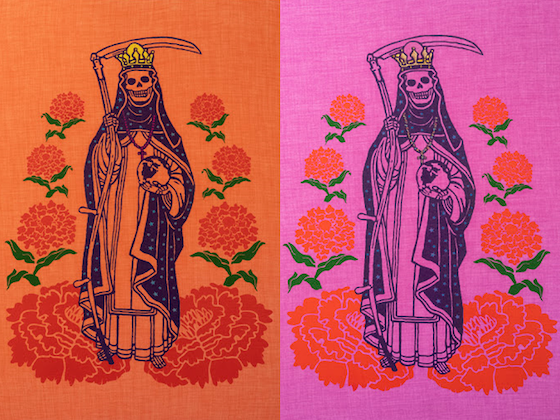Día de los Muertos Ofrenda
CinthYa Santos-Briones
October 14-November 19, 2023
Free. Open Daily 10am-5pm.
Historic Chapel

Día de los Muertos (Day of the Dead), a holiday rooted in pre-Hispanic traditions, contemporary indigenous practices, and influenced by Roman Catholicism, is celebrated throughout Mexico, in parts of Latin America, and across the Mexican diaspora. The spirits of the dead are welcomed back for a short period of time and are revered through music, dancing, gatherings with family and friends, and ofrendas (offerings made on home altars). Green-Wood commissioned Brooklyn-based artist Cinthya Santos-Briones to create this community altar in recognition of the holiday. Visitors are encouraged to pay tribute to lost loved ones by lighting candles and by leaving personal offerings, including flowers, photographs, food, and notes.
In Mictlán, Santos-Briones heavily draws inspiration from Mexican indigenous traditions. The title of the installation refers to the underworld of Aztec mythology, one of the four places where the souls of the departed would spend eternity based on their cause of death. The community altar is designed as a pyramid, inspired by the ceremonial center of Huapalcalco, a pre-Columbian city inhabited by the Toltec. Although one of oldest sites in America, its architectural style was lost, along with associated customs and traditions, in the sixteenth century when Europeans colonized the region and forced conversion to Christianity.
The centerpiece at the front of the Chapel features skulls—symbols predominant in Día de los Muertos celebrations—crafted from brightly colored fabrics with elaborate floral patterns. Sourced from markets in the artist’s hometown of Tulancingo, these fabrics are used in carnivals and to decorate kitchens throughout Mexico. The arrangement of the skulls in neat, orderly rows is intended to mimic those found in tzompantli, public altars constructed by the Maya and Aztecs out of the remains of captive warriors or prisoners sacrificed to Huitzilopochtli (the Aztec god of the sun and war). Around the Chapel are fabric versions of papel picado (cut-paper decorations), adorned with adaptations of lithographer Jose Guadalupe Posadas’ illustrations, such as “La Calavera Catrina,” a skeleton wearing a comically oversized hat with flowers and feathers. Embroidered canvases feature Santa Muerte (Holy Death), a popular cult figure, and as the artist explains, “one of the most revered patron saints in the transnational space for migrants.” With the exception of their skull face, Santa Muerte resembles the Virgin Mary, having a long flowing veil, heavenly crown, and halo, demonstrating the unique intersection of Catholic imagery and folk worship in Mexico today.
Santos-Briones is a visual artist, educator, and cultural organizer with indigenous Nahua roots based in New York. As an artist, her work focuses on a multidisciplinary social practice that combines participatory art and the construction of collective narratives. Her photography has been published in The New York Times, Vogue, and The New Yorker, among others. Mictlán will be her first large scale installation. To learn more about her work and current projects, visit her website.